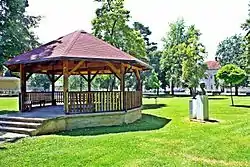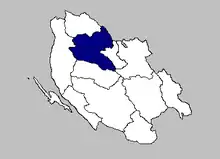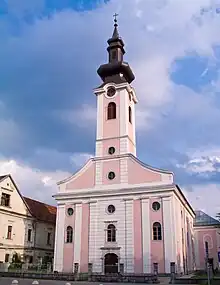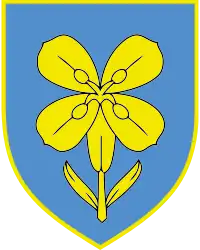Otočac
Otočac (pronounced [ɔtɔ̌tʃats]) is a town in Croatia, former bishopric and present Latin Catholic titular see. It lies in the northwestern part of Lika region, in the Gacka river valley. The population of the administrative area of the Town of Otočac was 9,778 in 2011, with 4,240 in Otočac itself, the majority of whom were Croats (91%).
Otočac | |
|---|---|
| Grad Otočac Town of Otočac | |
 Park in Otočac | |
 Otočac Location of Otočac within Croatia | |
| Coordinates: 44°52′N 15°14′E | |
| Country | |
| County | |
| Government | |
| • Mayor | Stjepan Kostelac (Ind.) |
| Area | |
| • Town | 565.0 km2 (218.1 sq mi) |
| • Urban | 21.5 km2 (8.3 sq mi) |
| Population (2021)[2] | |
| • Town | 8,332 |
| • Density | 15/km2 (38/sq mi) |
| • Urban | 3,852 |
| • Urban density | 180/km2 (460/sq mi) |
| Time zone | UTC+1 (CET) |
| • Summer (DST) | UTC+2 (CEST) |
| Postal code | 53220 |
| Area code | 053 |
| Website | otocac |

Name
The town is known as Otocsán in Hungarian, Ottocio in Italian,[3] and Ottocium in Latin.[4] In historical sources, the name has been rendered as Ottochaz (German and English), Ottocaz (Italian and German), and Ottotschaz, Ottotschan, & Ottocsaz (German).
History
Otočac was named after the early Croatian parish. The text of the famous Baška Tablet (around 1100) says that the church of St. Nicholas in Otočac was part of the order community with the Church of St. Lucy, Jurandvor on the island of Krk. From 1300 on, it belonged to the estate of the Frankopan family. Sigismund Frankopan (1461–1535) founded a diocese there (see below). The settlement with a defence tower, at a bend in the river Gacka, was protected by a towered fort. After the fort's demolition in 1829, only parts remained preserved. To provide a safer defence, a Renaissance-era fortress ("Fortica") was built in 1619, with a triangular layout of cylindrical towers.[5]
The Baroque parish church of the Holy Trinity, erected in 1684 (restored in 1774), is a large one-nave building with rounded sanctuary; three side chapels are on each side of the nave. The bell tower rises from the main front. The late baroque and classicist furnishings of the church include seven altars, a pulpit, baptismal font and sepulchral slabs from the 18th century.
From 1746, Otočac was the headquarters of a regiment (Ottotschaner Grenz-Infanterie Regiment N°II) of the Croatian Military Frontier, (Croatian Vojna Krajina). A number of harmonious, simple, mostly two-story houses originate from this period. Until 1918, Otočac was part of the Austrian monarchy (part of the Kingdom of Croatia-Slavonia subordinate to the Kingdom of Hungary after the compromise of 1867).[6] In the late 19th century and early 20th century, Otočac was part of the Lika-Krbava County of Croatia-Slavonia.
During the World War II Genocide of Serbs by the Ustaše, Otočac was the site of the slaughter of some 331 Serbs in late April 1941. The victims were forced to dig their own graves before being hacked to death with axes. Among the victims was the local Orthodox priest and his son. The former was made to recite prayers for the dying as his son was killed. The priest was then tortured, his hair and beard was pulled out, eyes gouged out before he was skinned alive.[7]
During the Croatian War of Independence the city was occupied by Serbian forces, but was later liberated by the Croats. It was later defended by the boškarini of the 154th Brigade HV, which in the following years visited the city. An armistice agreement was signed in January 1992, but the surroundings of Otočac were finally liberated only in 1995.[8][9][10]
Ecclesiastical History
A bishopric was established in 1460, on territory split from the Roman Catholic Diocese of Senj, which local estate owner Sigismund Frankopan (1461–1535) founded at the church of St. Nicholas and Jelena (née Keglević), widow of Juraj Mikuličić, who was a member of the community of the Divine Holy Spirit in Rome, gave to the church three parcels of land.[11][12] Initially it was suffragan of the Metropolitan Archdiocese of Salona, later of the Archdiocese of Split. In 1534 it was suppressed and its territory returned to its mother diocese of Senj.
Residential Suffragan Bishops
- Biagio Nicolai (1460.06.04 – death 1492?)
- Giovanni Chericato, Crosier Canons (O.Cruc.) (1492.05.09 – 1493.08.16), later Bishop of Kotor (Montenegro) (1493.08.16 – death 1514)
- Vincenzo de Andreis (1493.09.06 – 1520?)
- Pietro de Andreis (1520.10.19 – 1534?)
Titular see
It was nominally restored in 1933 as a Latin titular bishopric.
It had had the following incumbents, so far the fitting Episcopal (lowest) rank :
- Patrick Webster, Benedictine Order (O.S.B.) (1969.06.26 – 1970.03.07) as Auxiliary Bishop of Diocese of Saint George’s in Grenada (Grenada) (1969.06.26 – 1970.03.07) and as Apostolic Administrator of Saint George’s in Grenada (1969.08.05 – 1970.03.07), succeeding as Bishop of Saint George’s in Grenada (1970.03.07 – 1974.11.18), later Metropolitan Archbishop of Castries (Saint Lucia) (1974.11.18 – 1979.05.10)
- Maurice Paul Delorme, Prado (1975.10.02 – death 2012.12.27) as Auxiliary Bishop of Archdiocese of Lyon (France) (1975.10.02 – retired 1994.12.03) and as emeritate
- Joaquím Humberto Pinzón Güiza, Consolata Missionaries (I.M.C.) (2013.02.21 – ...), Apostolic Vicar of Puerto Leguízamo–Solano (Colombia).
Demographics
According to 2011 census, the Town of Otočac had 9,778 inhabitants, of whom 91.18% were Croats and 7.25% were Serbs. Croats in the vicinity of Otočac form two groups, those who speak Chakavian dialect and Bunjevci, who speak Shtokavian dialect with an Ikavian accent. Serbs form a majority in the villages of Gorići and Staro Selo. The settlement of Otočac itself had population of 4,240.
Before the Croatian War of Independence, the 1991 census lists the greater municipality of Otočac as having 24,992 inhabitants, with 16,355 Croats (65.44%) and 7,781 Serbs (31.13%).
| population | 21304 | 21878 | 22144 | 23841 | 27177 | 26826 | 26301 | 25634 | 22899 | 21096 | 19230 | 18310 | 16715 | 16113 | 10411 | 9778 | 8332 |
| 1857 | 1869 | 1880 | 1890 | 1900 | 1910 | 1921 | 1931 | 1948 | 1953 | 1961 | 1971 | 1981 | 1991 | 2001 | 2011 | 2021 |
Politics
Minority councils and representatives
Directly elected minority councils and representatives are tasked with consulting tasks for the local or regional authorities in which they are advocating for minority rights and interests, integration into public life and participation in the management of local affairs.[13] At the 2023 Croatian national minorities councils and representatives elections Serbs of Croatia fulfilled legal requirements to elect 15 members minority council of the Town of Otočac with only 13 members being elected in the end.[14]
Geography
Otočac is located in the western part of Gacko Polje, the karst field of centrally located Gacka river, located between Velebit and Mala Kapela, at an elevation of 459m. The town lies to the southeast of Senj, northwest of Gospić and west of Plitvice.
There are two town sections, the Upper Town and Lower Town.
Settlements
|
|
|
|
Gallery
.2.JPG.webp) Guards wearing a traditional Lika uniform of the Military Frontier
Guards wearing a traditional Lika uniform of the Military Frontier Brown bear at the Kuterevo bear sanctuary
Brown bear at the Kuterevo bear sanctuary Memorial to fallen Croatian defenders of the Croatian War of Independence
Memorial to fallen Croatian defenders of the Croatian War of Independence.JPG.webp) Monument of Žikmund (Sigismund) Frankopan, Lord of the town in the 15th century
Monument of Žikmund (Sigismund) Frankopan, Lord of the town in the 15th century_-_Ulica_kralja_Zvonimira.jpg.webp) King Zvonimir Street
King Zvonimir Street Otočac airfield
Otočac airfield Holy Trinity Church
Holy Trinity Church
Notable natives and residents
References
- Register of spatial units of the State Geodetic Administration of the Republic of Croatia. Wikidata Q119585703.
- "Population by Age and Sex, by Settlements, 2021 Census". Census of Population, Households and Dwellings in 2021. Zagreb: Croatian Bureau of Statistics. 2022.
- Cfr. alle p. 396, p. 929 e a p. 1897 sull' Annuario Pontificio - 1994.
- Ottocium (Titular See) at catholic-hierarchy.org, Retrieved on 25 May 2017.
- Opll, Ferdinand; Krause, Heike; Sonnlechner, Christoph, eds. (2017). Wien als Festungsstadt im 16. Jahrhundert: Zum kartografischen Werk der Mailänder Familie Angielini (in German). Böhlau Verlag Wien. p. 407. ISBN 9783205202103.
- Edwin Mueller. Handbook of Austria and Lombardy-Venetia Cancellations on the Postage Stamp Issues 1850-1864, 1961.
- Cornwell, John (2000). Hitler's Pope: The Secret History of Pius XII. Penguin. pp. 251–252. ISBN 978-0-14029-627-3.
- "MEMBERS OF THE 154TH BRIGADE IN THE TOWN OF OTOČAC". Archived from the original on 2021-01-28. Retrieved 2021-01-21.
- "Otočac su danas posjetili članovi Udruge hrvatskih branitelja Domovinskog rata – 154. brigade koja okuplja hrvatske branitelje sa područja Umaga, Buja i NovigradaC".
- "154th Brigade HV".
- Bihać i biháćka krajina, str. 146, Radoslav Lopasić, Matica hrvatska, 1890.
- Monumenta spectantia historiam slavorum meridionalium, Volume 42-43, page XXXV, Croatian Academy of Sciences and Arts, Academia Scientiarum et Artium Slavorum Meridionalium, 1917.
- "Manjinski izbori prve nedjelje u svibnju, kreću i edukacije". T-portal. 13 March 2023. Retrieved 10 June 2023.
- "Informacija o konačnim rezultatima izbora članova vijeća i izbora predstavnika nacionalnih manjina 2023. IX. LIČKO-SENJSKA ŽUPANIJA" (PDF) (in Croatian). Državno izborno povjerenstvo Republike Hrvatske. 2023. p. 5. Retrieved 13 June 2023.
